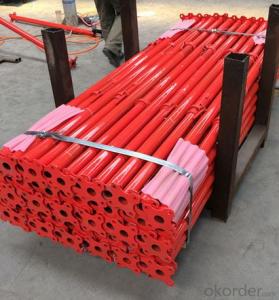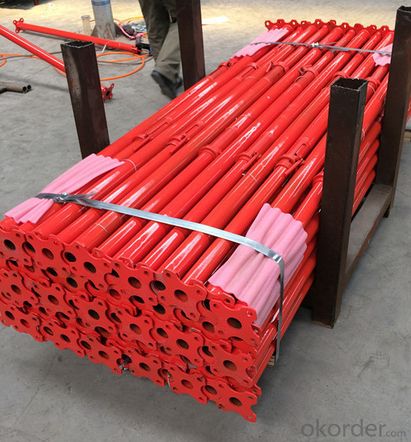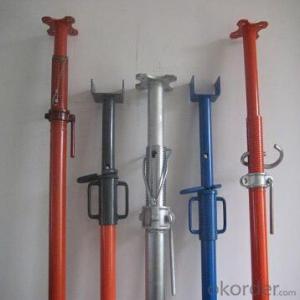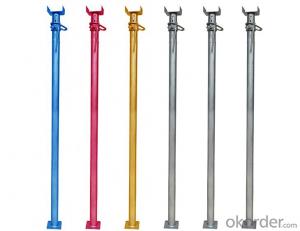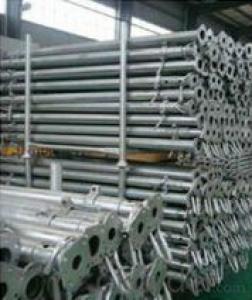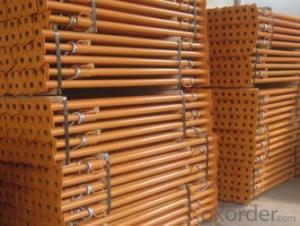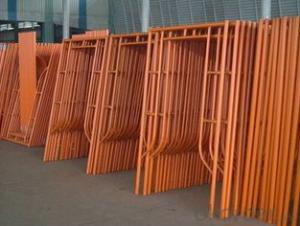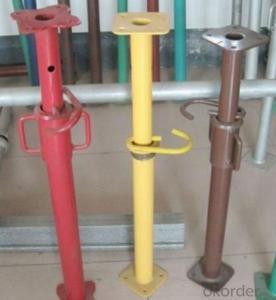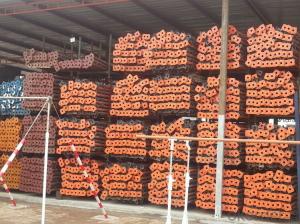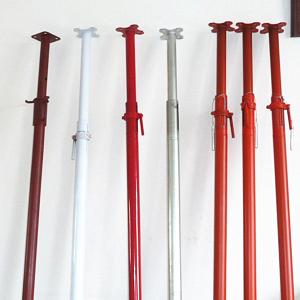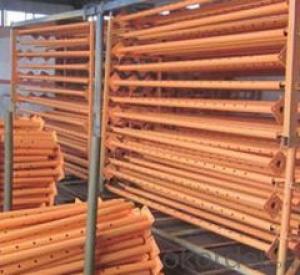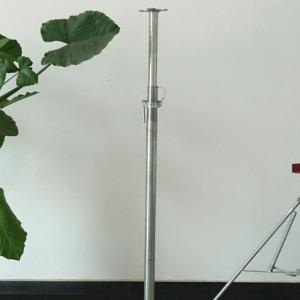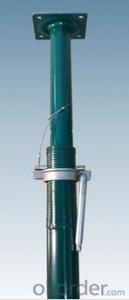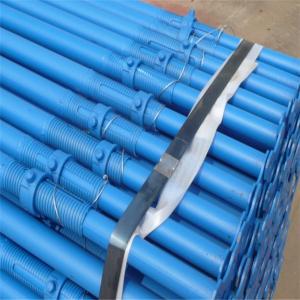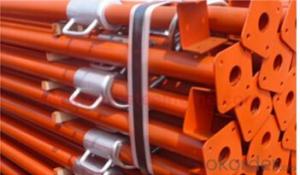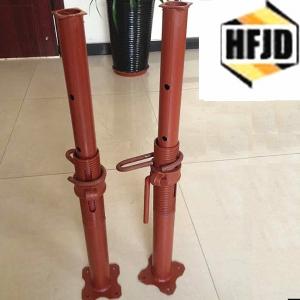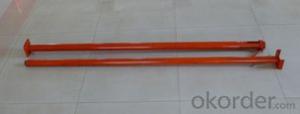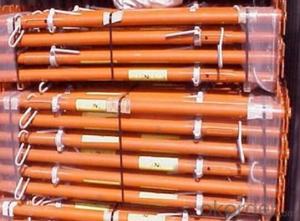Stable and durable steel scaffolding shoring prop
- Loading Port:
- Tianjin
- Payment Terms:
- TT OR LC
- Min Order Qty:
- 10000 PCS
- Supply Capability:
- 10000 PCS/month
OKorder Service Pledge
OKorder Financial Service
You Might Also Like
Quick Details
| Model Number: | SP scaffolding shoring prop | ||||
| Material: | Q235 steel pipe | Color: | dark red, green, blue | Surface treatment: | painted, powder coated, galvanized |
| Certification: | SGS;BV | Length: | 1600-4000mm | Thickness: | 1.8/2.0/2.2/2.5/3.0mm |
| Technique: | CO2 arc welded | Inner tube diameter: | 40/48mm | Outer tube diameter: | 48/56/60mm |
| Application: | scaffolding shoring prop for slab and formwork supporting |
Packaging & Delivery
| Packaging Detail: | 1.Scaffolding shoring prop is in a bundle with a wire which is in bare package. 2.One 20 GP container can load around 1500-2000 pieces of props. |
| Delivery Detail: | 10-20 days after deposit |
Specifications
scaffolding shoring prop
1.For slab supporting
2.CO2 arc welded technique
3.High loading capacity
4.Rust-proof
SpecificationsChina)
| Product | Model | Specifications |
scaffolding shoring prop | Inner tube diameter |
40/48mm |
| Outer tube diameter |
48/56/60mm | |
| Tube thickness |
1.8/2.0/2.2/2.5/3mm | |
| Adjustable length | 1600-2900mm 1800-3200mm 2000-3600mm 2200-4000mm |
*We can provide diffenet sizes and types of scaffolding shoring prop for you .
- Q: How is a steel prop different from other types of props?
- A steel prop is different from other types of props due to its material composition. Unlike wooden or aluminum props, a steel prop is made entirely of solid steel, which provides enhanced strength, durability, and load-bearing capacity. Steel props are known for their high resistance to compression and ability to support heavy loads, making them ideal for construction and temporary support applications.
- Q: Can steel props be used for supporting temporary signage and billboards?
- Certainly, temporary signage and billboards can be supported using steel props. In construction and building projects, steel props are frequently employed to offer temporary stability and support. They possess durability, strength, and a capacity to withstand heavy loads, making them appropriate for holding up large and weighty signage and billboards. Furthermore, steel props can be conveniently adjusted and securely fixed at various heights and angles, allowing for flexibility in positioning the signage or billboard to maximize visibility. By utilizing steel props, the stability and safety of these temporary structures are ensured, providing a dependable support system for temporary signage and billboards.
- Q: Can steel props be used in the construction of temporary parking structures?
- Yes, steel props can be used in the construction of temporary parking structures. Steel props, also known as steel shoring or temporary supports, are commonly used in construction projects to provide temporary support to structures. They are strong, durable, and capable of bearing heavy loads, making them suitable for temporary parking structures where stability and safety are crucial.
- Q: Can steel props be used in the construction of temporary bridges?
- Yes, steel props can be used in the construction of temporary bridges. Steel props provide strong support and stability to the bridge structure, making them suitable for temporary constructions where durability and safety are essential.
- Q: How do steel props compare to other types of support systems?
- Steel props have gained high regard in the construction industry due to their superior strength, durability, and versatility compared to other support systems. One primary benefit of steel props lies in their exceptional load-bearing capacity. They are specifically designed to endure heavy loads and offer reliable support to structures during construction or renovation endeavors. This makes them particularly suitable for providing support to large beams, slabs, and columns. Furthermore, steel props provide a wide range of adjustable heights and extensions, enabling precise leveling and support in various construction scenarios. These props can be effortlessly adjusted to the required height and securely locked in position, guaranteeing stability and safety throughout the construction process. When compared to other support systems like wooden or concrete props, steel props exhibit greater resistance to deformation, bending, and compression. Their sturdy construction and high-quality materials make them less prone to damage or failure, thus providing a more secure and dependable support solution. Additionally, steel props are lightweight and easy to handle, making them convenient to transport, assemble, and disassemble. They require minimal labor and time, contributing to enhanced efficiency and productivity on construction sites. Another advantage of steel props stems from their reusability. Unlike wooden or concrete props, which may deteriorate over time and require replacement, steel props can be used repetitively, making them a cost-effective option in the long term. This reusability aspect also makes them more environmentally friendly, reducing waste and minimizing the need for new materials. In conclusion, steel props offer numerous advantages over alternative support systems. Their exceptional load-bearing capacity, adjustability, durability, and reusability make them a popular choice in the construction industry. They provide a reliable and efficient support solution, ensuring safety and stability during construction or renovation projects.
- Q: Can steel props be used for temporary support during HVAC system installation?
- Yes, steel props can be used for temporary support during HVAC system installation. Steel props are adjustable and provide sturdy support, making them suitable for holding up heavy equipment like HVAC systems during installation.
- Q: How do you ensure proper weight distribution when using steel props?
- To ensure proper weight distribution when using steel props, it is important to follow a few key steps. Firstly, it is crucial to inspect the props for any damages or defects before use. This ensures that the weight is evenly distributed and prevents any potential accidents or collapses. Secondly, the props should be placed at regular intervals along the load-bearing structure, taking into account the required load capacity. Additionally, adjusting the props to the correct height is essential for maintaining proper weight distribution. Finally, it is crucial to use appropriate locking mechanisms or securing devices to prevent any potential movement or shifting of the props during use. By following these steps, proper weight distribution can be ensured, providing stability and safety when using steel props.
- Q: Can steel props be used in the construction of prefabricated buildings?
- Steel props, which are also referred to as steel supports or scaffolding props, have the capability to be utilized in the construction of prefabricated buildings. In the realm of construction, steel props are commonly employed to provide temporary support to structures throughout building and renovation projects. Prefabricated buildings are fabricated using pre-engineered components that are manufactured away from the construction site and subsequently transported for assembly. During the assembly procedure, steel props can be employed to offer support to the prefabricated components, thus guaranteeing stability and structural integrity. With adjustable height and easy installation and removal, steel props are well-suited for utilization in the construction of prefabricated buildings.
- Q: What are the characteristics of hysteretic curves of steel supports
- Hysteresis curveIt is shown that the shape of hysteresis curve is very full, which reflects the ability of plastic deformation of the whole structure or component. Such as bending, bias, bending and shearing failure of bending shear component, which has good plastic deformation ability of the steel frame structure or component P delta hysteretic curve is a spindle.The bow has the pinch effect, which shows that the hysteresis curve is affected by the slip. The shape of the hysteresis curve is full, but the full extent than the spindle should be low, reflecting the whole structure or component plastic deformation capacity is relatively strong, low cyclic loading tests of good performance, can better absorb seismic energy. For example, the shear span is relatively large, the shear force is small, and is equipped with a certain stirrup bending shear members and members of the bending and shear.
- Q: Are steel props suitable for supporting temporary retail structures?
- Yes, steel props are suitable for supporting temporary retail structures. Steel props offer a high level of strength and stability, making them reliable for supporting the weight and ensuring the structural integrity of temporary retail structures. Additionally, steel props can be easily adjusted and secured in place, making them convenient for accommodating different sizes and layouts of retail structures.
Send your message to us
Stable and durable steel scaffolding shoring prop
- Loading Port:
- Tianjin
- Payment Terms:
- TT OR LC
- Min Order Qty:
- 10000 PCS
- Supply Capability:
- 10000 PCS/month
OKorder Service Pledge
OKorder Financial Service
Similar products
Hot products
Hot Searches
Related keywords
